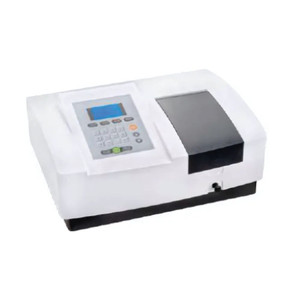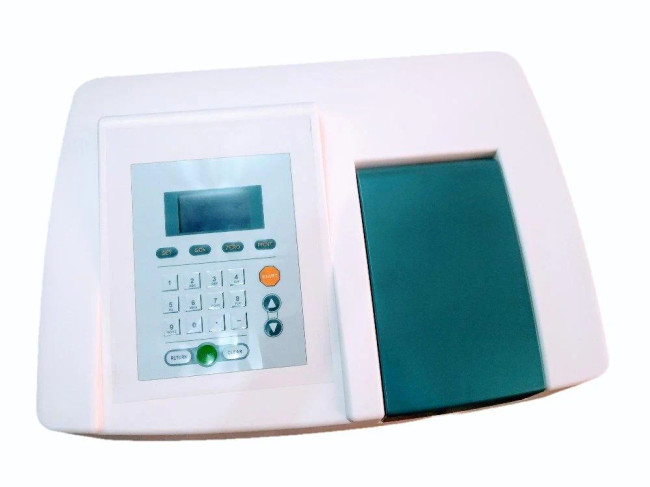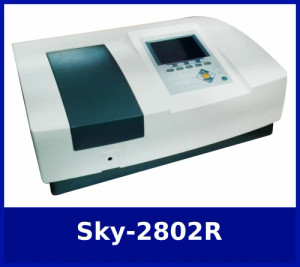Spectrophotometer SKY-285
The Spectrophotometer SKY-285 is a versatile and widely used instrument for measuring the absorbance or transmittance of light through a solution. It operates on the principle of spectrophotometry, which involves quantifying the interaction of light with matter. By analyzing the absorbance or transmittance of light at different wavelengths, researchers and analysts can determine the concentration of substances, characterize materials, and study chemical reactions. The Spectrophotometer SKY-285, while a specific model, shares many characteristics with other single-beam spectrophotometers in its class, and this discussion will address those commonalities while highlighting the general features one might expect in such an instrument. Specific details about the SKY-285's unique functionalities should be obtained from the manufacturer's documentation.
Principles of Spectrophotometry: Spectrophotometer SKY-285
Spectrophotometry is based on the Beer-Lambert Law, which states that the absorbance of a solution is directly proportional to the concentration of the absorbing species and the path length of the light beam through the solution. This relationship allows for quantitative analysis of substances based on their absorbance properties.
Key Features and Components:
A typical spectrophotometer like the Spectrophotometer SKY-285 incorporates several key components and features:
- Light Source: The light source provides a continuous spectrum of light across a specific wavelength range. Tungsten-halogen lamps are commonly used for visible and near-infrared regions, while deuterium lamps are used for the ultraviolet region. The Spectrophotometer SKY-285 likely uses one or both of these lamp types, though specific details would be in the product literature.
- Monochromator: The monochromator selects a specific wavelength of light from the source. It typically uses a diffraction grating or prism to disperse the light and isolate the desired wavelength. The quality of the monochromator influences the instrument's spectral resolution and accuracy.
- Sample Compartment: The sample compartment holds the sample being analyzed. It is designed to minimize stray light and ensure accurate measurements. Cuvettes, typically made of quartz or glass, are used to hold the sample solution. The path length of the cuvette is a critical factor in absorbance measurements.
- Detector: The detector measures the intensity of light that passes through the sample. Photodiodes or photomultiplier tubes (PMTs) are commonly used detectors. The detector's sensitivity and linearity are important factors influencing the instrument's performance.
- Display and Output: The instrument's display shows the measured absorbance or transmittance values. Modern spectrophotometers often include digital displays and data output ports for connecting to computers or printers.
Calibration and Operation:
Proper calibration is essential for accurate spectrophotometric measurements. A blank solution, containing all components except the analyte of interest, is used to calibrate the instrument to zero absorbance. Standard solutions of known concentrations are then used to create a calibration curve, which relates absorbance to concentration.
Typical Operation: Spectrophotometer SKY-285
- Wavelength Selection: Select the desired wavelength for the analysis. This wavelength should correspond to the maximum absorbance of the analyte.
- Blank Measurement: Place the blank solution in the sample compartment and calibrate the instrument to zero absorbance.
- Sample Measurement: Replace the blank solution with the sample solution and measure the absorbance or transmittance.
- Data Analysis: Use the calibration curve or Beer-Lambert Law to determine the concentration of the analyte in the sample.
Applications: Spectrophotometer SKY-285
Spectrophotometers like the Spectrophotometer SKY-285 find applications in various fields:
- Quantitative Analysis: Determining the concentration of substances in solutions, such as proteins, DNA, and other biomolecules.
- Chemical Kinetics: Studying the rates of chemical reactions by monitoring changes in absorbance over time.
- Material Characterization: Measuring the absorbance spectra of materials to identify and characterize their optical properties.
- Environmental Monitoring: Analyzing water and soil samples for pollutants and other contaminants.
- Clinical Chemistry: Measuring the concentration of various analytes in biological fluids for diagnostic purposes.
Advantages of the Spectrophotometer SKY-285 (and similar instruments):
While specific advantages of the Spectrophotometer SKY-285 would need to be confirmed in the product documentation, general advantages of this class of instrument include:
- Ease of Use: Single-beam spectrophotometers are generally straightforward to operate, requiring minimal training.
- Cost-Effectiveness: They are typically more affordable than more complex double-beam instruments.
- Compact Design: They often have a small footprint, making them suitable for laboratories with limited space.
Limitations:
- Single-Beam Design: Fluctuations in the light source can affect the accuracy of measurements. While some single-beam instruments have compensating mechanisms, they are generally less accurate than double-beam instruments, which compensate for these fluctuations in real-time.
- Limited Wavelength Range: The wavelength range of the instrument is limited by the light source and monochromator.
The Spectrophotometer SKY-285, or any similar single-beam spectrophotometer, can be a valuable tool for various applications. Understanding its principles of operation, key components, and limitations is crucial for obtaining accurate and reliable results. Always consult the manufacturer's documentation for specific details about the instrument's functionalities and specifications.
Microprocessor UV-VIS SKY-285 Spectrophotometer
| Technical Parameters |
Values |
| Optical system |
CT grating monochromator |
| Wavelength range |
195 nm - 1020nm |
| Wavelength accuracy |
#ERROR! |
| Spectral bandwidth |
2nm |
| Wavelength repeatability |
1 nm |
| Stray light |
<= 0.3%T @220nm |
| Photometric accuracy |
#ERROR! |
| Photometric repeatability |
0.2%T |
| Stability |
#ERROR! |
| Work Pattern |
T, A, C |
| Display area |
0-200%T, -0.3 -3A |
| Display modes |
4 LCD |
| Zero setting |
automatic |
| Weight |
12 kg |








